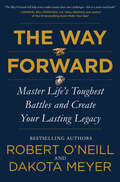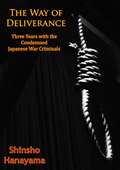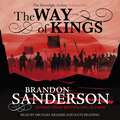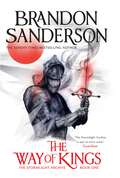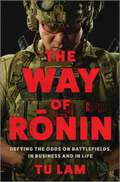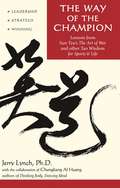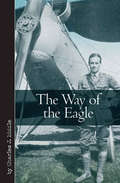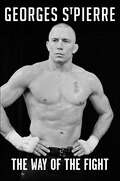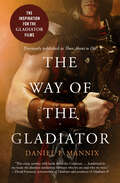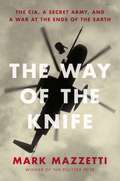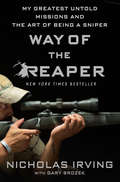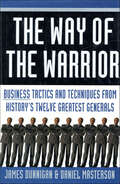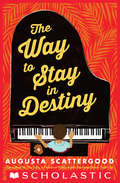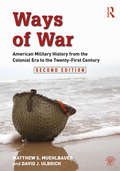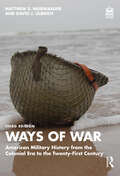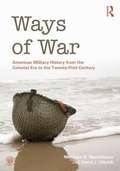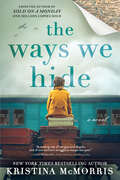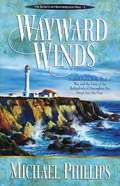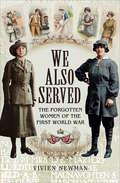- Table View
- List View
Waves of Hate: Naval Atrocities of the Second World War
by Tony BridglandWhilst researching his earlier book Sea Killers in Disguise, the author unearthed a rich stem of incidents at sea which happened during the two World Wars that shocked and surprised him. This book is the result of further in-depth study covering the Second World War. It reveals a long catalogue of atrocities perpetrated not just by Germany and Japan but, sensationally, by the British and her Allies.Thanks to Tony Bridgland's meticulous research, into a wide variety of incidents at sea, makes for vivid and compelling, if uneasy, reading
Waves of War: Nationalism, State Formation, and Ethnic Exclusion in the Modern World
by Andreas WimmerWhy did the nation-state emerge and proliferate across the globe? How is this process related to the wars fought in the modern era? Analyzing datasets that cover the entire world over long stretches of time, Andreas Wimmer focuses on changing configurations of power and legitimacy to answer these questions. The nationalist ideal of self-rule gradually diffused over the world and delegitimized empire after empire. Nationalists created nation-states wherever the power configuration favored them, often at the end of prolonged wars of secession. The elites of many of these new states were institutionally too weak for nation-building and favored their own ethnic communities. Ethnic rebels challenged such exclusionary power structures that violated the principle of self-rule, and neighboring governments sometimes intervened into these struggles over the state. Waves of War demonstrates why nation-state formation and ethnic politics are crucial to understand the civil and international wars of the past 200 years.
The Way Forward: Master Life's Toughest Battles and Create Your Lasting Legacy
by Robert O'Neill Dakota Meyer“The Way Forward will help every reader master their own challenges—this is a must-read book!” —Admiral Bill McRaven, U.S. Navy (Retired) and author of the #1 New York Times bestseller Make Your BedAmerican Sniper meets Make Your Bed in these life lessons from decorated United States service members and New York Times bestselling authors Robert O’Neill and Dakota Meyer—an in-depth, fearless, and ultimately redemptive account of what it takes to survive and thrive on battlefields from Afghanistan and Iraq to our daily lives, and how the perils of war help us hold onto our humanity.Rob O’Neill and Dakota Meyer are two of the most decorated and recognized US service members: O’Neill killed the world’s most wanted man, Osama bin Laden, and Meyer was the first living Marine to receive the Medal of Honor since the Vietnam War. But beyond their actions and courage in combat, O’Neill and Meyer also have much in common in civilian life: they are both sought-after public speakers, advocates for veterans, and share a non-PC sense of humor. Combining the best of military memoirs and straight-talking self-help, The Way Forward alternates between O’Neill’s and Meyer’s perspectives, looking back with humor at even the darkest war stories, and sharing lessons they learned along the way.The Way Forward presents O’Neill and Meyer’s philosophy in combat and life. This isn’t a book about the glory of war and combat, but one about facing your enemies, some who are flesh and blood and some that are not: Your thoughts. Your doubts. Your boredom and your regrets. From Rob’s dogged repetition at the free throw line of his childhood basketball court to Dakota’s pursuit of EMT and firefighter credentials to aid accident victims, these two American heroes turn their experiences into valuable lessons for every reader. Gritty and down-to-earth, O’Neill and Meyer tell their stories with candor and vulnerability to help readers handle stress, tackle their biggest obstacles, and exceed their expectations of themselves, while keeping life’s battles in perspective with a sense of humor.
The Way of Deliverance: Three Years with the Condemned Japanese War Criminals
by Hideo Suzuki Shinsho HanayamaOriginally published in 1950, this is the English translation of the book written by the Buddhist chaplain in Sugamo Prison who attended the Japanese war criminals before their execution. It is a collection of the records of the condemned that Shinsho Hanayama collected during his spiritual guidance in order to show "an ardent hope for peace" as well as an "awakening to religious ecstasy."Hanayama tells of the services held, the preparation of the men for death, the traditional rites, and the prisoners' deepening reverence as the days passed. He also recorded in details the last words, wills and letters of 27 condemned prisoners, and later those of the seven A class war criminals sentenced to death by hanging for war crimes, crimes against humanity, and crimes against peace--including General Hideki Tōjō (later Prime Minister of Japan), who was responsible for ordering the attack on Pearl Harbor.A fascinating, historically significant read.
The Way of Kings: The Stormlight Archive Book One (STORMLIGHT ARCHIVE)
by Brandon Sanderson'I loved this book. What else is there to say?' Patrick RothfussAccording to mythology mankind used to live in The Tranquiline Halls. Heaven. But then the Voidbringers assaulted and captured heaven, casting out God and men. Men took root on Roshar, the world of storms. And the Voidbringers followed...They came against man ten thousand times. To help them cope, the Almighty gave men powerful suits of armor and mystical weapons, known as Shardblades. Led by ten angelic Heralds and ten orders of knights known as Radiants, mankind finally won.Or so the legends say. Today, the only remnants of those supposed battles are the Shardblades, the possession of which makes a man nearly invincible on the battlefield. The entire world is at war with itself - and has been for centuries since the Radiants turned against mankind. Kings strive to win more Shardblades, each secretly wishing to be the one who will finally unite all of mankind under a single throne.On a world scoured down to the rock by terrifying hurricanes that blow through every few day a young spearman forced into the army of a Shardbearer, led to war against an enemy he doesn't understand and doesn't really want to fight. What happened deep in mankind's past? Why did the Radiants turn against mankind, and what happened to the magic they used to wield?
The Way of Kings: The first book of the breathtaking epic Stormlight Archive from the worldwide fantasy sensation (STORMLIGHT ARCHIVE #1)
by Brandon SandersonThe groundbreaking first book of an epic series that has changed the face of fantasy. The Way of Kings begins The Stormlight Archive.Speak again the ancient oaths:Life before death.Strength before weakness.Journey before Destination.Return to men the Shards they once bore.The Knights Radiant must stand again.Roshar is a world of stone and storms. Uncanny tempests of incredible power sweep across the rocky terrain so frequently that they have shaped ecology and civilization alike. Animals hide in shells, trees pull in branches, and grass retracts into the soilless ground. Cities are built only where the topography offers shelter.It has been centuries since the fall of the ten consecrated orders known as the Knights Radiant, but their Shardblades and Shardplate remain: mystical swords and suits of armor that transform ordinary men into near-invincible warriors. Men trade kingdoms for Shardblades. Wars were fought for them, and won by them.One such war rages on a ruined landscape called the Shattered Plains. There, Kaladin, who traded his medical apprenticeship for a spear to protect his little brother, has been reduced to slavery. In a war that makes no sense, where ten armies fight separately against a single foe, he struggles to save his men and to fathom the leaders who consider them expendable.Brightlord Dalinar Kholin commands one of those other armies. Like his brother, the late king, he is fascinated by an ancient text called The Way of Kings. Troubled by over-powering visions of ancient times and the Knights Radiant, he has begun to doubt his own sanity.Across the ocean, an untried young woman named Shallan seeks to train under an eminent scholar and notorious heretic, Dalinar's niece, Jasnah. Though she genuinely loves learning, Shallan's motives are less than pure. As she plans a daring theft, her research for Jasnah hints at secrets of the Knights Radiant and the true cause of the war.Readers love The Way of Kings:'A masterpiece series in epic fantasy' Novel Notions'It's multi-POV, action-packed, heartfelt, exciting, thrilling' Goodreads reviewer, ⭐ ⭐ ⭐ ⭐ ⭐'The story is mind-blowing' Goodreads Reviewer, ⭐ ⭐ ⭐ ⭐ ⭐'[It's] elevated the art of storytelling to a different league' Goodreads reviewer, ⭐ ⭐ ⭐ ⭐ ⭐'Introduces a series that will change the history of Fantasy' Goodreads reviewer, ⭐ ⭐ ⭐ ⭐ ⭐'I really wish I could give The Way of Kings a sixth star' Goodreads reviewer, ⭐ ⭐ ⭐ ⭐ ⭐Other books by Brandon SandersonThe CosmereThe Stormlight ArchiveThe Way of KingsWords of RadianceEdgedancer (Novella)OathbringerRhythm of WarWind and TruthThe Mistborn SagaMistbornThe Well of AscensionThe Hero of AgesThe Alloy of LawShadows of SelfThe Bands of MourningThe Lost Metal
The Way of Ronin: Defying the Odds on Battlefields, in Business and in Life
by Tu LamFrom Special Forces veteran and internationally respected teacher of Ronin Tactics to streaming and videogame fan favorite, Tu Lam&’s memoir will captivate, astonish, exhilarate, and even profoundly resonate.Tu Lam has become known not just for his accomplishments as a decorated Green Beret, but also for his work outside the military, including: Training citizens and law enforcement professionals all over the country Providing aid to both active and retired soldiers with physical and mental health issues Co-hosting the History Channel&’s Forged in Fire: Knife or Death Appearing in and contributing to the world&’s bestselling video game, Call of Duty: Modern WarfareIn The Way of Ronin, he reveals his against-all-odds story. Tu Lam&’s resilience, dedication, and relentless pursuit of freedom saw him achieving Full Spectrum US Special Operations across twenty-seven countries worldwide for more than twenty years, only to pay the price of his own physical and mental trauma as well as addiction.That decision led him to more than two decades of grueling instruction in every facet of the special forces, then deployment to war and conflict zones—all while channeling his inner anger in secret underground no-holds-barred fighting matches. When he finally retired from the military after more than two decades, his demons caught up with him, leading to years of addiction. But even that didn&’t defeat him. Confronting his demons, he emerged triumphant. Now he shares the gripping details and riveting intricacies of this awe-inspiring journey.Tu Lam&’s life is, at times, all too real, and at many others times, almost unbelievable. For fans of Jocko Willink and David Goggins, The Way of Ronin is an ultimately triumphant autobiography of what one man can accomplish against seemingly insurmountable odds.
The Way of the Champion: Lessons from Sun Tzu's the Art of War and Other Tao Wisdom for Sports & Life
by Chungliang Al Huang Jerry LynchMartial artists, great warriors, coaches, generals, and successful corporate CEOs have all effectively used the strategies for winning found in Sun Tzu's Art of War.<P><P>Authors Jerry Lynch and Chungliang Al Huang, using lessons from the The Art of War, as well as other ancient Taoist books such as the I Ching and Tao Te Ching, teach readers to develop the capacities and qualities that make a champion-such as high self-esteem, courage, fortitude, determination, perseverance, tenacity, self-awareness, integrity, the ability to take risks, and the ability to learn from failure.The emphasis on self-awareness, tactical positioning, and strategic advantage means that practitioners win through inner growth and self-improvement-giving them a universal competitive edge.
The Way of the Eagle (Vintage Aviation Library)
by Charles J. BiddleA classic aviation memoir: an American pilot&’s account of air combat in the First World War. Charles J. Biddle, a Philadelphia native, was active in France beginning in 1917, where he flew as a volunteer, initially for the French in Escadrille 73, and then in the American 103rd Aero Squadron, the Lafayette Escadrille, and then the 13th Aero Squadron and 4th Pursuit Group, which he commanded. His memoir was published shortly after his return to the United States and provides an immediacy lacking in other books that were written later. Accounts of US pilots from this period are relatively rare, and this one paints a compelling picture of a group of Americans fighting as volunteers for the French. Biddle&’s US compatriots soon established their own capability and wrung free of French direction—and as this book reveals, it was largely because of their combat prowess. For his service, Biddle was awarded the French Legion of Honour, the Croix de Guerre, the American Distinguished Service Cross, and the Belgian Order of Leopold II. This memoir gives us a unique perspective on America&’s participation in the Great War.
The Way of the Fight
by Georges St-PierreA NEW YORK TIMES BESTSELLERFrom the world’s most popular UFC fighter, Georges “Rush” St. Pierre, comes a startlingly honest portrait of a fighter’s journey, highlighting the lessons that propelled his rise from bullying victim to internationally celebrated athlete and champion.There’s more to winning battles than fists and feetFor world-renowned professional fighter Georges St-Pierre, the greatest asset is not physical strength or athleticism—it’s a sense of purpose. From his beginnings as a small, mercilessly bullied child first discovering karate to his years as a struggling garbage collector who spent all his free time in the gym, his hard-fought rise in the sport of mixed martial arts, and his long, painful recovery from a career-threatening injury, Georges never lost sight of his ambition to become the greatest martial artist of all time. In The Way of the Fight, Georges for the first time reveals what propelled him not only to become a champion but to embrace obstacles as opportunities to build character.The Way of the Fight is an inspirational look into the mindset of a master. To Georges, all life is competition, and there’s no more perfect metaphor for competition than the life of a fighter. He explains the value of discipline, risk and even fear, with the wisdom of one who knows that nothing is assured—his next fight could always be his last. Drawing inspiration from fighting legends, Eastern philosophy and a trusted inner circle, The Way of the Fight is a powerful, life-changing guide to living with purpose and finding the way to accomplish your loftiest goals.
The Way of the Gladiator: Inspiration for the Gladiator Films
by Daniel P. MannixThe book that inspired the stories of Gladiator & Gladiator II: Step into the ring with this classic, in-depth account of the ancient Romans&’ obsession with the bloody and brutal games.&“[The Way of the Gladiator is] this crazy, tawdry, wild book about the Coliseum. . . . It hardwired in my brain the absolute similarities between who we are and who we were.&” —David Franzoni, Academy Award–nominated screenwriter of Gladiator and producer of Gladiator IIOriginally published under the title Those About to Die. &“If you can imagine a superior American sports writer suddenly being transported back in time to cover the ancient Roman games, you will have some idea of the flavor and zest of The Way of the Gladiator,&” said the Los Angeles Times about Daniel P. Mannix&’s century-by-century—and nearly moment-by-moment—narrative of the Roman Empire&’s national institution. Putting the games in the context of Rome&’s rise and dramatic fall, Mannix captures all the history, planning, and savage pageantry that went into creating the first spectator sports. The games began in 238 BC as nearly county fair–like entertainment, with trick riding, acrobats, trained animals, chariot racing, and athletic events. The contests then evolved into slave fights thanks to wealthy patricians Marcus and Decimus Brutus, who wanted to give their father an unforgettable funeral by reviving an old tradition. What the brothers wrought, Rome devoured, demanding even greater violence to satisfy the bloodlust of the crowd. Architectural wonders in themselves, massive arenas like Circus Maximus and the Colosseum were built, able to host sea battle reenactments on actual water. Successful gladiators found fame, fortune—and freedom. But as Rome began to fall in the fifth century, so did the games, devolving into nothing more than pointless massacres. In the end, millions of humans and animals were sacrificed in barbaric displays. What were once ceremonies given in honor of gods met an inglorious fate, yet they still captivate—in book and in film—the imagination of people today.
The Way of the Heavenly Sword: The Japanese Army in the 1920's
by Leonard HumphreysThis text examines the history of the Japanese army in the 1920s. In this decade, the 'Meija military system' disintegrated and was replaced by a new 'Imperial Army System'. The Japanese victory over Russia in 1905 had changed the direction of Japanese military thought from almost total dependence on western rational military thinking to a more traditional reliance on morale as the preponderant factor for victory in combat. The author focuses on the intense and complex struggle which took place over leadership of the Army, the application of the principle of the primacy of morale, and the quite contradictory but obvious necessity for the army to modernize. This internal turmoil was intensified by a background of increasingly difficult economic circumstances, and the terrible effects of the great earthquake and fire of 1923. This crucial decade of Japanese history set the stage for the shattering events of the 1930s and 1940s.
The Way of the Knife: The CIA, a Secret Army, and a War at the Ends of the Earth
by Mark MazzettiA Pulitzer Prize-winning reporter's riveting account of the transformation of the CIA and America's special operations forces into man-hunting and killing machines in the world's dark spaces: the new American way of war. The most momentous change in American warfare over the past decade has taken place away from the battlefields of Afghanistan and Iraq, in the corners of the world where large armies can't go. The Way of the Knife is the untold story of that shadow war: a campaign that has blurred the lines between soldiers and spies, and lowered the bar for waging war across the globe. America has pursued its enemies with killer drones and special operations troops; trained privateers for assassination missions and used them to set up clandestine spying networks; and relied on mercurial dictators, untrustworthy foreign intelligence services, and proxy armies. This new approach to war has been embraced by Washington as a lower risk, lower cost alternative to the messy wars of occupation and has been championed as a clean and surgical way of conflict. But the knife has created enemies just as it has killed them. It has fomented resentments among allies, fueled instability, and created new weapons unbound by the normal rules of accountability during wartime. Mark Mazzetti tracks an astonishing cast of characters on the ground in the shadow war, from a CIA officer dropped into the tribal areas to learn the hard way how the spy games in Pakistan are played to the chain-smoking Pentagon official running an off-the-books spy operation, from a Virginia socialite whom the Pentagon hired to gather intelligence about militants in Somalia to a CIA contractor imprisoned in Lahore after going off the leash. At the heart of the book is the story of two proud and rival entities, the CIA and the American military, elbowing each other for supremacy. The CIA, created as a Cold War espionage service, is now more than ever a paramilitary agency ordered by the White House to kill off America's enemies--in the mountains of Pakistan and the deserts of Yemen, in the tumultuous civil wars of North Africa and the chaos of Somalia. For its part, the Pentagon has become more like the CIA, dramatically expanding spying missions everywhere. Sometimes, as with the raid that killed Osama bin Laden, their efforts have been perfectly coordinated. Other times, including the failed operations disclosed here for the first time, they have not. For better or worse, their struggles will define American national security in the years to come.
Way of the Reaper: My Greatest Untold Missions and the Art of Being a Sniper
by Gary Brozek Nicholas IrvingFrom the New York Times Bestselling Author and Co-Star of Fox's American Grit comes a rare and powerful book on the art of being a sniper. Way of the Reaper is a step-by-step accounting of how a sniper works, through the lens of Irving's most significant kills - none of which have been told before. Each mission is an in-depth look at a new element of eliminating the enemy, from intel to luck, recon to weaponry. Told in a thrilling narrative, this is also a heart-pounding true story of some of The Reaper's boldest missions including the longest shot of his military career on a human target of over half a mile.In Iraq and Afghanistan, Nick Irving earned his nickname in blood, destroying the enemy with his sniper rifle and in deadly firefights behind a .50 caliber machine gun. He engaged a Taliban suicide bomber during a vicious firefight, used nearly silent sub-sonic ammo, and was the target of snipers himself. Way of the Reaper attempts to place the reader in the heat of battle, experiencing the same dangers, horrors and acts of courage Irving faced as an elite member of the 3rd Ranger Battalion, 75th Ranger Regiment, while also examining the personal ramifications of taking another life.Readers will experience the rush of the hunt and the dangers that all snipers must face, while learning what it takes to become an elite manhunter. Like the Reaper himself, this explosive book blazes new territory and takes no prisoners.
The Way of the Warrior
by Diane CareyThe entire Alpha Quadrant has been threatened with deadly infiltration by the shape-shifting Founders of the Dominion. Already the Romulans and Cardassians have been decimated by the clandestine machinations of the Founders. Now the newly promoted Captain Benjamin Sisko of Deep Space Nine has another problem: a massive fleet of Klingon warships has arrived at DS9 on a secret mission. Unable to learn anything from an elusive Klingon general, Sisko turns to Lt. Commander Worf, formerly of the Starship Enterprise and the only Klingon in Starfleet, to try and uncover the truth. What Worf learns will have a profound impact on the future of the Alpha Quadrant, and Sisko must risk destroying the Federation-Klingon alliance to prevent a full-scale war!
The Way of the Warrior: Business Tactics and Techniques from History's Twelve Greatest Generals
by Daniel Masterson James DunniganBusiness and war: both are forms of conflict, and both have more in common than people think. Business, like war, is the art of outdoing the competition. Businesses, like armies, need to practice strategic thinking and understand the nature of competitive conflict. CEOs devise business plans to win in the marketplace; generals use strategic thinking to win wars.In The Way of the Warrior James Dunnigan and Daniel Masterson reveal the management lessons of history's finest twelve military leaders, including: Alexander the Great, on having vision; Genghis Khan, on quick decisions; Julius Caesar, on communication; Napoleon, on managing change; Ulysses S. Grant, on the art of the turnaround; Douglas MacArthur, on coping with disaster; and Norman Schwarzkopf, on building alliances. The management hubris of these men is directly applicable in today's business world.Comprehensive, insightful, and extremely accessible, The Way of the Warrior won't show you how to call in air strikes on the competition, but it will show you how to be a manager who never loses his cool under fire.
Way of the Warrior Kid: From Wimpy to Warrior the Navy Seal Way
by Jocko WillinkFifth grade was the worst year of Marc's life. He stunk at gym class, math was too hard for him, the school lunch was horrible, and his class field trip was ruined because he couldn't swim. But what was the most awful thing about fifth grade? Kenny Williamson, the class bully, who calls himself the "King of the Jungle. " When Marc's mother tells him that his Uncle Jake is coming to stay for the whole summer, Marc can't wait. Uncle Jake is a for real, super-cool Navy SEAL. And Uncle Jake has a plan. He's going to turn Marc into a warrior. Becoming a warrior isn't easy. It means a lot of pull ups, sit ups, pushups, squats, swimming, eating right, and studying harder than ever before! Can Marc transform himself into a warrior before school starts in the fall - and finally stand up to the King of the Jungle himself? The Way of the Warrior Kid is a new illustrated chapter book by #1New York Times-bestselling author and retired Navy SEAL Jocko Willink.
The Way to a Soldier's Heart
by Gina WilkinsA family for her daughter? Elle O'Meara's happy being a single mom to her adopted two-year-old, Charlotte. Even so, when Shane Scanlon starts coming in to her bakeshop, he becomes a bright spot in her days. The handsome former army medic even strikes up a friendship with her daughter, making Elle wonder if there's room in her life for the excitement he could bring. Then Elle discovers why Shane's really there: he's Charlotte's biological uncle and wants her in his family. Elle prefers to believe he won't take Charlotte away, but he's already lied once. Now she doesn't know if her connection with Shane was real-or just another lie.
The Way to Stay in Destiny
by Augusta ScattergoodFrom the author of the acclaimed GLORY BE, a novel that celebrates baseball, fast piano, and small-town living in the wake of the Vietnam War.When Theo gets off a bus in Destiny, Florida, he's left behind the only life he's ever known. Now he's got to live with Uncle Raymond, a Vietnam War vet and a loner who wants nothing to do with this long-lost nephew. Thank goodness for Miss Sister Grandersole's Boarding House and Dance School. The piano that sits in Miss Sister's dance hall calls to Theo. He can't wait to play those ivory keys. When Anabel arrives things get even more enticing. This feisty girl, a baseball fanatic, invites Theo on her quest to uncover the town's connection to old-time ball players rumored to have lived there years before. A mystery, an adventure, and a musical exploration unfold as this town called Destiny lives up to its name. Acclaimed author Augusta Scattergood has delivered a straight-to-the-heart story with unforgettable characters, humor, and hard questions about loss, family, and belonging.
Ways of War: American Military History from the Colonial Era to the Twenty-First Century
by Matthew S. Muehlbauer David J. UlbrichFrom the first interactions between European and native peoples to the recent conflicts in Afghanistan and Iraq, military issues have always played an important role in American history. Now in its updated second edition, Ways of War comprehensively explains the place of the military within the wider context of the history of the United States, showing its centrality to American culture, economics, and politics. The fifteen chapters provide a complete survey of the American military's evolution that is designed for semester-length courses. Features of the revised and fully-updated second edition include: • Chronological and comprehensive coverage of North American conflicts in the seventeenth century and all wars undertaken by the United States; • New or expanded sections on Non-English Colonization in Northeast North America, the Beaver Wars, Pontiac’s War, causes of the American Revolution, borderlands conflict from 1848 to 1865, causes of the American Civil War, Reconstruction, the Meuse-Argonne Campaign, Barack Obama’s second term as president, the Syrian Civil War, and the rise of the Islamic State; • 50 revised maps, 20 new images, chapter timelines identifying key events, and text boxes providing biographical information and first-person accounts; • A companion website featuring a testbank of essay and multiple choice questions for instructors, as well as student study resources such as an interactive timeline, chapter summaries, annotated further readings, links to online resources, flashcards, and a glossary of key terms. Extensively illustrated and written by experienced instructors, the second edition of Ways of War remains essential reading for all students of American Military History.
Ways of War: American Military History from the Colonial Era to the Twenty-First Century
by Matthew S. Muehlbauer David J. UlbrichNow in its third edition, Ways of War is a comprehensive guide to United States military history and its wider relationship to American society, from the seventeenth century to the present day.This volume remains an accessible and compelling textbook for students and instructors, combining traditional “drum and bugle” history with “war and society” approaches to highlight the military’s influence on American culture, economics, and politics. The new edition contains over 60 maps, both new and revised, to further illustrate military battles, campaigns, and operations. Each chapter also includes a wealth of images alongside chapter timelines identifying key events, text boxes providing biographical information and first-person accounts, and short bibliographies. The final two chapters have been fully updated to include vital material on the end of the withdrawal of American forces from Afghanistan in 2021, as well as information on new military technology and artifical intelligence that have changed warfare in recent years.Written by experienced instructors and designed to maximize student engagement, the third edition of Ways of War remains an essential text for American military history and war and society courses.Instructor and student resources for this book include a test bank of multiple choice, discussion, and essay questions; interactive timelines; annotated and expanded bibliographies for each chapter; and chapter glossaries and flashcards.
Ways of War: American Military History from the Colonial Era to the Twenty-First Century
by David J. Ulbrich Matthew S. MuehlbauerFrom the first interactions between European and native peoples, to the recent peace-keeping efforts in Afghanistan and Iraq, military issues have always played an important role in American history. Ways of War comprehensively explains the place of the military within the wider context of the history of the United States, showing its centrality to American culture and politics. The chapters provide a complete survey of the American military's growth and development while answering such questions as: How did the American military structure develop? How does it operate? And how have historical military events helped the country to grow and develop?<P><P> Features Include:<P> * Chronological and comprehensive coverage of North American conflicts since the seventeenth century and international wars undertaken by the United States since 1783<P> * Over 100 maps and images, chapter timelines identifying key dates and events, and text boxes throughout providing biographical information and first person accounts<P> * A companion website featuring an extensive testbank of discussion, essay and multiple choice questions for instructors as well as student study resources including an interactive timeline, chapter summaries, annotated further reading, annotated weblinks, additional book content, flashcards and an extensive glossary of key terms.<P> Extensively illustrated and written by experienced instructors, Ways of War is essential reading for all students of American Military History.
The Ways We Hide: A Novel
by Kristina McMorris"The Queen's Gambit meets The Alice Network in this epic, action-packed novel of family, loss, and one woman's journey to save all she holds dear—including freedom itself." —Kristin Harmel, New York Times bestselling author of The Forest of Vanishing StarsFrom the New York Times bestselling author of Sold on a Monday—over a million copies sold—comes a sweeping World War II tale of an illusionist whose recruitment by British intelligence sets her on a perilous, heartrending path.As a little girl raised amid the hardships of Michigan's Copper Country, Fenna Vos learned to focus on her own survival. That ability sustains her even now as the Second World War rages in faraway countries. Though she performs onstage as the assistant to an unruly escape artist, behind the curtain she's the mastermind of their act. Ultimately, controlling her surroundings and eluding traps of every kind helps her keep a lingering trauma at bay.Yet for all her planning, Fenna doesn't foresee being called upon by British military intelligence. Tasked with designing escape aids to thwart the Germans, MI9 seeks those with specialized skills for a war nearing its breaking point. Fenna reluctantly joins the unconventional team as an inventor. But when a test of her loyalty draws her deep into the fray, she discovers no mission is more treacherous than escaping one's past. Inspired by stunning true accounts, The Ways We Hide is a gripping story of love and loss, the wars we fight—on the battlefields and within ourselves—and the courage found in unexpected places.
Wayward Winds
by Michael PhillipsHigh above the English coastline, political storms swirled far more turbulent than any natural storm. Indeed, the silent clouds moving steadily but inexorably westward were thick and black and worldwide in their scope. Yet few apprehended the threat. It was not only nationalism, liberalism, the rising expectation of the middle class, and the political instability of the European power structure that made this a dangerous time. There were unseen currents of deceit and deception lurking silent but lethal beneath the surface of European affairs. And some, masquerading under a cloak of truth and enlightenment, gave no hint of their subversive loyalties. As England and the rest of Europe approach a climax when the world will be changed forever, the Aurnerrorout or Devonshire stand, too, in a peril they have no way to foresee. Estranged from her family, twenty-year-old Amanda has left Heathersleigh Hall for what seems an exciting world in prewar London and the suffragette movement. Determined to make an impact and stand on her own two feet, she has no idea of danger surrounding her on all sides.
We Also Served: The Forgotten Women of the First World War
by Vivien NewmanA social history of British women&’s brave yet forgotten service during WWI from a historian of female wartime experiences—includes photos. At the outbreak of World War I, women looking to contribute to the Allied effort were told by the war office to &“go home and sit still.&” Thankfully, hundreds of thousands of women from all corners of society ignored that advice and lent their collective strength to the cause. In We Also Served, Vivien Newman digs beneath the myths surrounding women&’s war efforts to reveal stories of determination and heroism. Becoming nurses, munitions workers, members of the Land Army, ambulance drivers, and surgeons, women stepped readily into a world normally occupied by men. Some served with the Armed Forces, others funded and managed their own hospitals within sight and sound of the guns. At least one British woman bore arms, and over a thousand women lost their lives as a direct result of their involvement with the war. This profoundly important history by an expert in female wartime experiences lets these all but forgotten voices finally be heard. &“A short book rich in facts and personal testimonies.&” —Historical Novel Society


